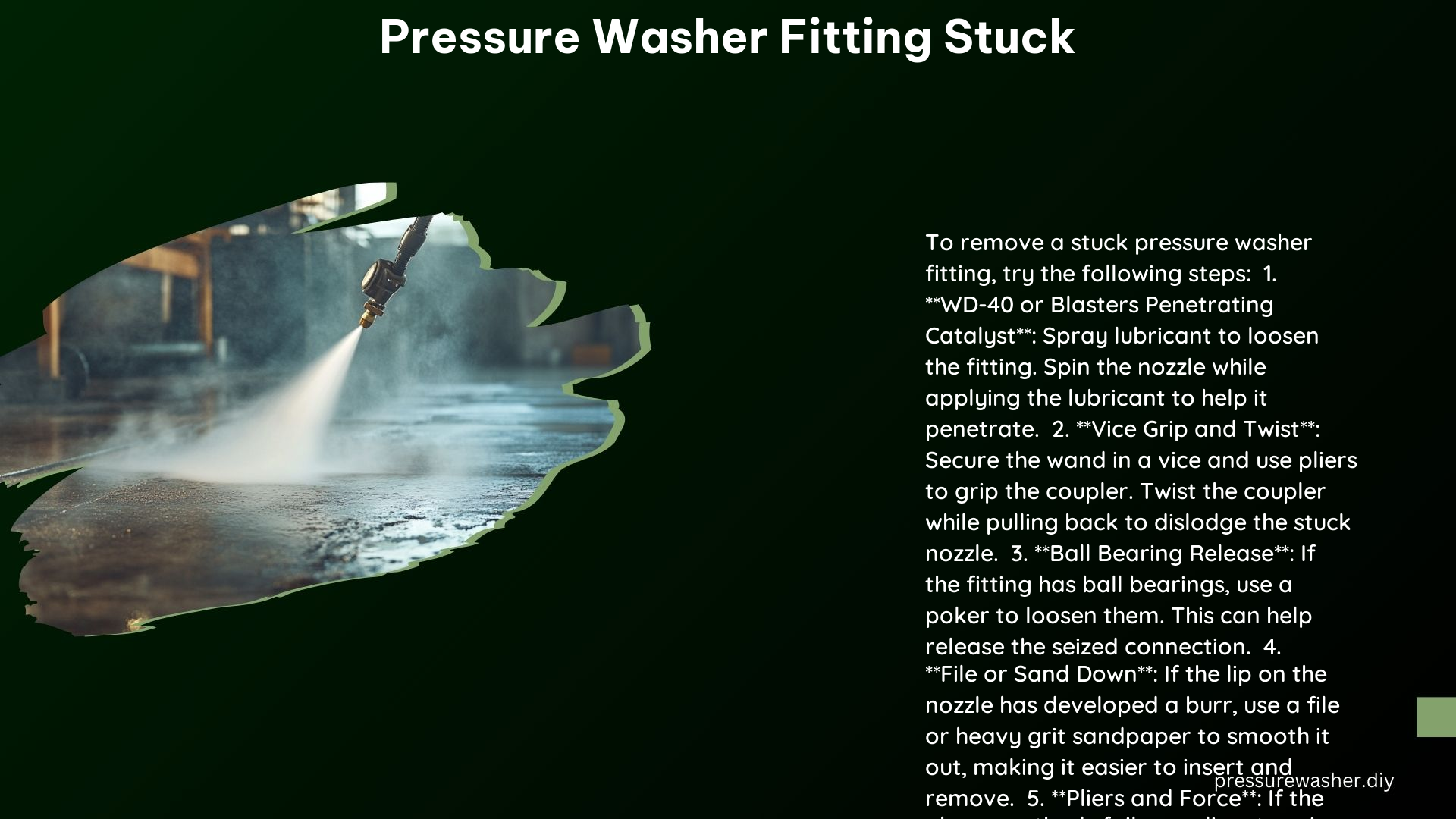Pressure washer fittings can become stuck due to various reasons, including corrosion, overtightening, and wear and tear. This comprehensive guide will provide you with a detailed understanding of the causes, effective methods for removal, and preventive measures to ensure your pressure washer fittings remain in optimal condition.
Causes of Stuck Pressure Washer Fittings
-
Corrosion: Pressure washer fittings, particularly those made of brass, can be susceptible to corrosion when exposed to harsh chemicals or environmental factors. The corrosion can cause the fittings to swell, making them difficult to remove. For example, using brass fittings with bleach, a common cleaning agent, can accelerate the corrosion process and lead to stuck fittings.
-
Overtightening: Applying excessive force when tightening pressure washer fittings can cause them to become stuck. The high level of torque can deform the threads or create burrs on the surface, making it challenging to unscrew the fitting.
-
Wear and Tear: Over time, the steel balls in quick-disconnect fittings can create divots or grooves in the mating surfaces. This wear and tear can cause the fittings to swell and become stuck, preventing a smooth disconnection.
-
Debris and Dirt: Accumulation of dirt, debris, or mineral deposits within the pressure washer fittings can interfere with the smooth operation of the connections, leading to stuck fittings.
Removing Stuck Pressure Washer Fittings

-
WD-40 and Pliers: Spray a generous amount of WD-40 or a similar penetrating lubricant onto the stuck fitting and let it soak in for a few minutes. Then, use a pair of pliers to grip the fitting and twist it back and forth while pulling. The lubricant can help break down the corrosion or debris, making the fitting easier to remove.
-
Channel Locks: Channel locks, also known as water pump pliers, can be an effective tool for removing stuck pressure washer fittings. Grip the coupling with the channel locks and twist it back and forth to break the seal and loosen the fitting.
-
Vice and Vice Grips: Secure the pressure washer wand in a vise and use vice grips to grip the coupler. Gently pull back on the coupler while twisting it to break it free.
-
Pliers and Poker: Use a pair of pliers to firmly grip the fitting, and then use a poker or other thin tool to try to dislodge the seized ball bearings that may be preventing the fitting from being removed.
-
Filing and Sanding: If the fitting has developed burrs or lips on the tip, use a file or heavy-grit sandpaper to carefully remove them. This can help create a smoother surface, making it easier to insert and remove the fitting.
Prevention
-
Use Stainless Steel Fittings: Opt for stainless steel pressure washer fittings, as they are more resistant to corrosion compared to brass or other metal fittings. Stainless steel fittings can help prevent the formation of stuck connections.
-
Regular Maintenance: Regularly clean and lubricate the pressure washer fittings to prevent the buildup of corrosion, debris, and mineral deposits. This can be done by disconnecting the fittings, wiping them down with a clean cloth, and applying a small amount of silicone-based lubricant or penetrating oil.
-
Avoid Overtightening: When assembling the pressure washer, be mindful not to overtighten the fittings. Follow the manufacturer’s recommended torque specifications to ensure a secure connection without causing damage.
-
Replace Fittings Regularly: As the pressure washer fittings age and experience wear and tear, consider replacing them proactively. This can help prevent the formation of stuck connections and ensure the smooth operation of your pressure washer.
Technical Specifications
-
Quick Disconnects: Quick-disconnect fittings are commonly used in pressure washers to allow for easy attachment and detachment of accessories, such as wands, hoses, and nozzles. These fittings can become stuck due to corrosion, overtightening, or wear and tear on the internal steel balls.
-
Thread Sizes: Pressure washer fittings come in various thread sizes, typically ranging from 1/4-inch to 3/4-inch NPT (National Pipe Thread). Using the correct thread size is crucial to ensure a proper and secure connection, as mismatched fittings can lead to leaks and stuck connections.
-
Plugs and Adapters: Pressure washer accessories, such as plugs and adapters, can also become stuck if not properly maintained or if they are not compatible with the specific fittings on your pressure washer. Ensuring the use of the correct plugs and adapters can help prevent stuck connections.
References
- JustAnswer: “Quick Disconnect Stuck on Pressure Washer Water Inlet” – https://www.justanswer.com/small-engine/8eupl-quick-disconnect-stuck-pressure-washer-water.html
- Pressure Washing Resource: “Stuck Quick Release?” – https://pressurewashingresource.com/community/t/stuck-quick-release/15037
- RedFlagDeals: “Garden Hose Stuck in Pressure Washer Water Inlet” – https://forums.redflagdeals.com/garden-hose-stuck-pressure-washer-water-inlet-2369786/
- YouTube: “How to Remove a Stuck Tip Off a Pressure Washing Wand” – https://www.youtube.com/watch?v=l6PB4DXWdI4
- Reddit: “Help My Wand Quick Connect Nozzle is Stuck and Won’t Come Out” – https://www.reddit.com/r/pressurewashing/comments/umznih/help_my_wand_quick_connect_nozzle_is_stuck_and/
